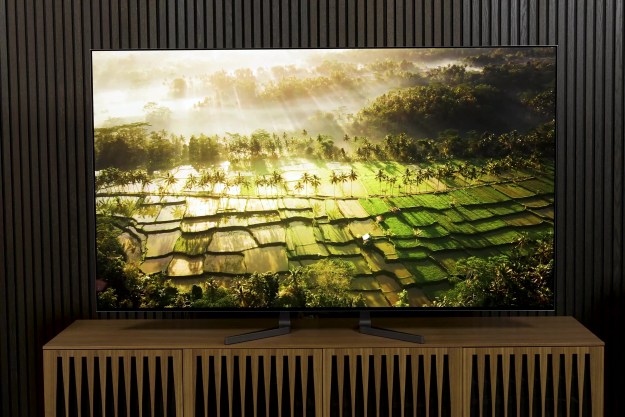
- Gorgeous OLED picture quality
- Low-latency wireless for gaming
- Solid wireless signal connection
- Easy setup
- Good sound
- Wireless box needs true line of sight
When I first saw the LG M3 Wireless OLED TV at CES 2023, I thought it was a pretty clever idea: A gorgeous OLED TV that can hang on the wall with no worries of running wires to it? Sounds like a winner!
But the funny thing about CES is that the excitement and energy that flows through that massive tech show tends to make you forget that sometimes the products we see there never see the light of day outside the show. Fortunately, LG has a history of bringing the products it shows off at trade shows to market. The LG M3 wireless OLED TV is no exception — you can buy it right now.
As I prepared myself for this review, I was concerned there might not be a lot to say about the LG M3. But reviewing the M3 turned out to be a lot more fun than I expected! I came away with some helpful information on how the wireless system works, as well as the final word on picture quality with this setup. All of the panel-related internals of this TV are otherwise identical to the LG G3 OLED, which you can read about in my full review from earlier this year.
Let’s talk first about how the wireless feature works. That is, after all, what we’re really here for.
Wireless connectivity tests
In short, it works pretty well. We launched straight into a torture test to figure out what the range and line-of-sight claims LG makes look like in real life. As a reminder, LG claims up to 30 feet on line of sight. And whenever you claim a range like that, you expect some variables.
Distance and line of sight
In order to test both the distance and line-of-sight reliance, I took the included Zero Connect box upstairs to the loft of our studio, and that got me about 25 feet of distance from the TV. I used the on-screen signal checker to track the signal strength and get tips on how to improve it, if needed. But there’s also an LED indicator on the top of the Zero Connect box that tells me the same thing. Blue is awesome, green is good, yellow is getting into dicey territory, and red is a no-go.
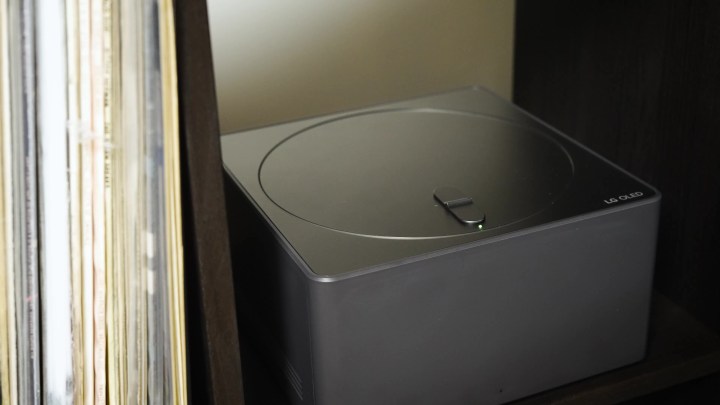
So long as the Zero Connect box had line of sight, and by that, I mean the box could “see” this little receiver section on the bottom of the display, that light stayed blue. That is, unless, I went out of my way to try to interrupt it. If I put my hand over this receiver on the display, I could get the signal to drop a bit — which looked like dropped frames on the TV. But, when just walking around the rooms both upstairs and down, the signal stayed solid and I saw no alteration to the picture whatsoever. If, however, I dropped the Zero Connect down behind the little knee wall, then we could see some initial interruptions. You can see the LED on the Zero connect box going yellow at first, then eventually green — and at times it was full-on Blue as well.
Take some time to work out the best signal strength.
That is what happened initially. However, as the Zero Connect box remained in that location behind the knee wall for a while, what I noticed was that the connection became more stable. Now, this is just a theory, but it seemed that like a lot of wireless devices, the Zero Connect box had done some wireless channel surfing, settled on the channel that worked best, and locked it in. Again, that’s just the story I’m telling myself based on the behavior I witnessed. But the fact is that the signal locked in stronger over time, which I like a great deal.
While the Zero Connect box was up in that location, slightly obscured by the knee wall, I adjusted its antenna by swiveling the dial and the lever on top of the box. But ultimately, the best results came from pointing this at the TV. I also tested different sources, including a 4K Sony Blu-ray disc player and our Xbox Series X console, and the source didn’t matter, as the resulting picture quality was the same.
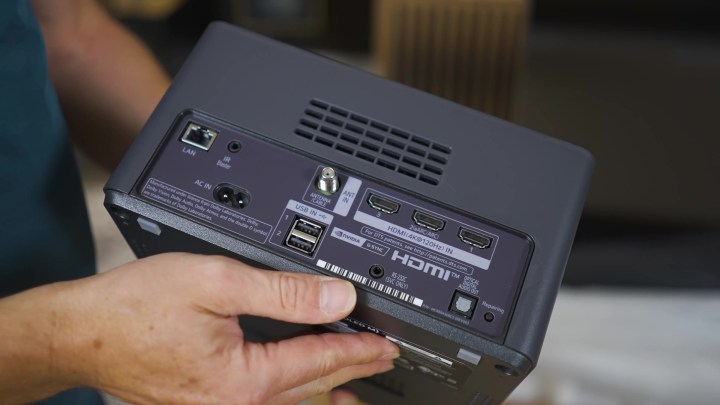
Continuing with the Zero Connect Box placement tests, I brought the unit downstairs and placed it in the back of the room, with a clear line of sight to the TV, and the LED remained Blue the entire time. I was not able to interrupt the signal by walking around — again, I had to cover up the Zero Connect box, or the wireless receiver module on the display, to get it to trip up. This kind of deliberate move doesn’t seem like a real-world scenario to me, but if you make an effort, you can affect the wireless signal.
Media console
Next, I moved the Zero Connect box into the media console and intentionally placed it under one of the shelves, so there were two layers of thick wood in between the box and the TV.
According to the signal strength meter, this was the most challenging placement. We’ve taken away line of sight, and the objects in the signal’s path are significant.

Before I discuss the results of this test, I want to talk about why I think this is a realistic scenario for some folks. Whether you wall mount this TV, or put it on a stand, you might want to put your gear in a console below the TV and have the luxury of not having to run any wires to the TV at all. Just provide power, and you’re good.
I like the idea of being able to put the equipment somewhere else entirely, especially if the location I choose is more suitable for using an over-the-air broadcast antenna where those signals come in best. But I think this is a more realistic scenario for most folks.
If you have an open cabinet, all the better. But even if your cabinet has doors like ours — though it is important to note the doors do have holes and perforations in the screen — you might do OK. Maybe.
While the light on the Zero Connect box remains yellow — which is code for “not ideal” or perhaps “tenuous” — I’ve had no problems with the TV’s picture performance over the past week or so. No dropped frames. No image interruptions at all.
There is one thing that I have to mention, though.
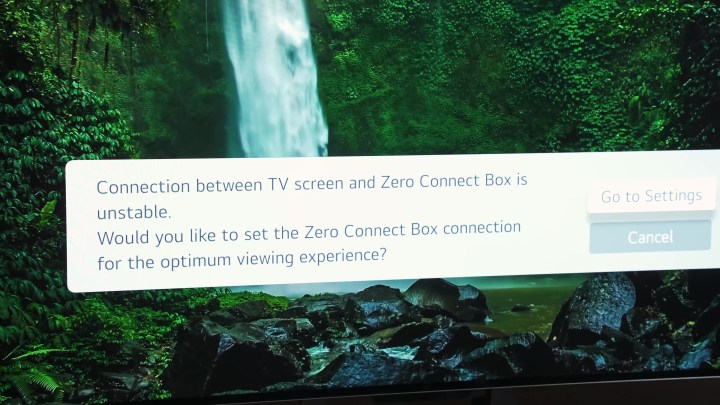
On one day in the last six (I believe it was Day 3), I kept getting this “weak signal” message on the TV. The picture never dropped out and there were no audio issues at all — no sign of struggle whatsoever. But this message popped up maybe 15 times while I was trying to watch a show. Interestingly, this seems to have coincided with my moving the BDI console back toward the wall a bit.
And then, just as quickly as it started, the warning message stopped, and I’ve not seen it since. This is just a theory, but I suspect that it may have taken a while for the Zero Connect box to lock onto a stable wireless channel. Whatever actually happened, though, it’s been three days of frequent TV use without seeing that message again. And, of course, the TV has performed flawlessly as far as the picture and audio goes.
The M3 has performed admirably from a wireless signal perspective.
This just goes to show that the invisible wireless signals we use every day can be hard to understand. We know that they are not omnidirectional, and we also know that they aren’t always linear. Despite the notion of line of sight, it is very possible for a wireless signal to bounce off of a hard surface and land exactly where it needs to be. It’s still directional, we just change the trajectory a bit (and, yes, mess with the strength in the process).
All of this is to say that even though I’ve thoroughly tested this wireless technology, your mileage will vary. You may get away with tucking the Zero Connect box away in a place that isn’t recommended. But then again, you may not. You may be able to place the box outside of its 30-foot range with the right conditions. Or your conditions may require less than 30 feet. I can’t predict what might happen with your use case. But I can say that I’m pretty optimistic because in this space, with all the torture tests I gave it, the M3 has performed really admirably from a wireless signal perspective.
Picture quality and latency
As for the picture quality and latency? I can’t tell any difference whatsoever between the M3’s wireless system and an HDMI cable connection. None. There’s no added compression or pixelization. Poor video source problems aren’t further exacerbated by the wireless connection. I don’t experience any perceivable lag with games, though admittedly I’m not a hardcore first-person shooter player. It’s important to note that the M3 had zero problems with 4K 120Hz gaming at all. It was smooth as silk. There was no alteration to motion resolution. Again, I might as well have had HDMI cables connected, but I didn’t, and I loved the sense of freedom that gave me.
Now, there are some restrictions involved here. If you want to use a soundbar other than one of LG’s own wireless soundbars, or an AV receiver, keep in mind that the ARC connection is on the Zero Connect box. There are exactly zero ports on the TV. So if you do want to use your own audio system, that means the Zero Connect box will need to be within an HDMI cable’s distance from those audio devices, which means you would need to house your equipment near the TV.
I can almost see you thinking: “LG should just add an HDMI input to the display itself.”
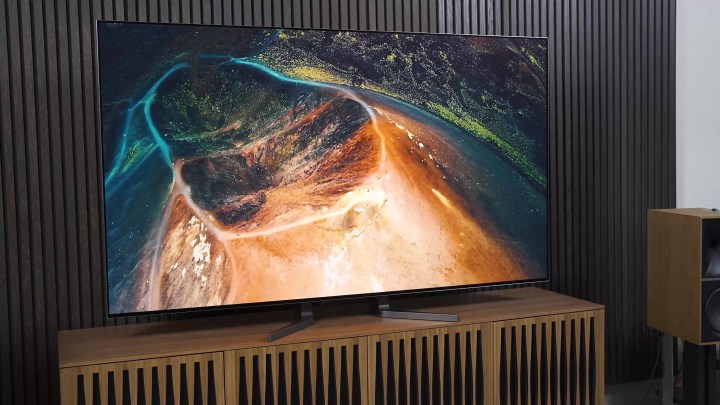
Except, it really isn’t that simple. If LG did that, it would have to add a whole board that had not only the HDMI input but processing to go with it as well. That’s unless it doubled up on the transmission so that it went from the display to the Zero Connect box for processing, and then back to the display. Butt hat would add cost, complexity, and probably some liabilities as well and, frankly, that just doesn’t make a whole lot of sense. I think the better fix would be for the WiSA audio standard to become more accepted, and then your audio system could be wireless as well.
Otherwise, I think the M3 works great. What a cool TV! I’ve had so much fun with it. I love the M3 in practice, but even more, I love what it could mean for the future.
Editors' Recommendations
- Best OLED TV deals: Save on LG C3, Samsung S90C, and more
- LG’s 2024 OLED M4 takes AI processing to new heights ahead of CES
- LG’s giant, wireless OLED TV gets a giant price
- LG’s giant 97-inch M3 OLED TV eliminates HDMI cables
- LG says its G3 OLED evo TV will be 70% brighter, with no visible wall gap









